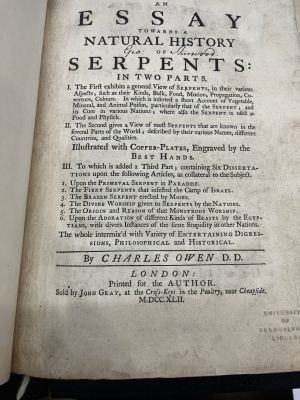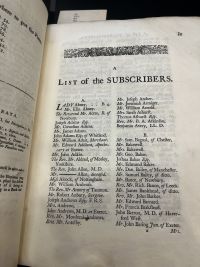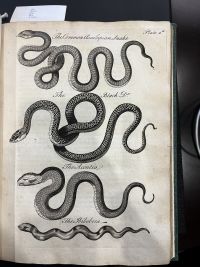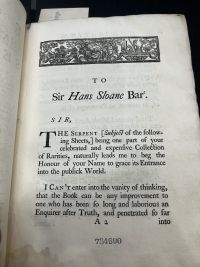Natural History of Serpents
An Essay Towards A Natural History Of Serpents is a book by Charles Owen published in 1742 in London. The book is broken down into three parts: The first part talks about a general view of serpents such as their motion, diet, habits, and physical features. The second part gives a view of serpents known in several parts of the world described by their names, countries, and qualities. Finally, The third part contains six dissertations that are collateral to the subject of the book. The book contains seven copper plates engravings, due to the high cost of having copper plate engravings, a solution was to incorporate subscriptions to help aid the printing of this book. The pages were most likely made from rags or linen. With the coming of a new scientific publishing era, this book is a prime example of a mix of both science and religious attributes and gives an insight on how early science books/papers were written.

Usage



Audience and Circulation
The audience was anyone who had an interest in serpents. It was written in a way that doesn't exclude anyone from reading it. Audiences could have ranged from collectors to students interested in researching serpents. The precise detail of the copper plate engravings also added features that could be enjoyed by various audiences. When it comes to circulation, the front title states "Sold by John Gray, at the Cross-Keys in the Poultry, near Cheapside". So, in the beginning, circulation started by being sold near Cheapside. Also, in early modern Britain, the primary means of creating, assembling, and sharing knowledge was through these types of books [1]. Another audience and source of circulation come from the people that subscribed to the printing of this book. In this specific copy was owned by George Sherwood and then was later owned by Charles W. Burr, a professor of nervous diseases at Upenn. Finally, it was given to Penn in 1925.
Subscriptions
Due to the high costs of printing, authors came to subscribers for financial help. Similar to subscriptions today, subscribers would financially help by donating money and in return have their names in the book as a subscriber and also get a copy of the book after printing. This book had many subscribers. This was due in part to how expensive the copper plate engravings were. This book contains seven engravings so printing a lot of copies would cost a lot of money. Thus, these subscribers would be some of the first people to start the circulation of this book.
Annotations and Marginalia
This copy doesn't contain any annotations or marginalia. A reason could be that the book was in the hands of collectors or people who just wanted to read for curiosity. Other copies of this book could definitely have annotations. A student studying what serpents eat and how they move proves as an example of where annotations can be made.
Historical Significance

Sir Han's Sloane
A very interesting part of this book is that there is a dedication to Sir Hans Sloane. Sir Hans Slone was a physician by trade but was also a collector of objects from around the world. [2]. Sloane collected more than 71,000 items and it became the founding collection of the British Museum. This dedication sparks the idea that this book was in fact a science book. The importance of this dedication is that we can see how early authors spread natural science knowledge.
1800 Science
A huge part of the significance of this book is to see how the evolution of science publishing has changed over time. Although this book was printed in the late 18th century, it contains details that are still seen in today's science textbooks. It contains an index for the reader to navigate and in the beginning includes printing errors and corrections. These traits are still prevalent in today's science texts. What's interesting is that although this is a science text, it still contains religious texts and ideas. The third section of this book contains six dissertations, some of which have religious ideas. The Brazen Serpent erected by Moses, Upon the Primeval Serpent in Paradise, and The Fiery Serpents that infested the Camp Of Israel are 3 dissertations that contain biblical ideas. The book has a mix of both natural and non-natural elements which gives insight into the publishing of academic works and how science and religion were perceived. It showed how science and religion were tied at the time. This mix of religion and science could have also been used to make the book less scientific so it can be enjoyed by various audiences. Before the Linnaean taxonomic system , a form of biological classification, naturalists identified and categorized natural objects by the use of reference systems to track specimens in knowledge exchanges between collectors and naturalists. [3]. This particular book doesn't contain any reference systems to identify the specimens which is partially due to the fact of the precise detail of the copper plate engravings and the appearance of the species name above the engravings. Overall this book is significant in learning more about how science was perceived in the 18th century and how it has changed throughout time.
Notes
- ↑ Yale, Elizabeth. “Introduction.: ‘A Whole and Perfect Bodie and Book’: Constructing the Human and Natural History of Britain.” Sociable Knowledge: Natural History and the Nation in Early Modern Britain, University of Pennsylvania Press, 2016, pp. 1–20. JSTOR, http://www.jstor.org/stable/j.ctt18z4hqs.5. Accessed 8 May 2023.
- ↑ British Museum, Sir Has Sloane, retrieved May 8 2023 from https://www.britishmuseum.org/about-us/british-museum-story/sir-hans-sloane
- ↑ Margócsy, Dániel. “‘Refer to Folio and Number’: Encyclopedias, the Exchange of Curiosities, and Practices of Identification before Linnaeus.” Journal of the History of Ideas, vol. 71, no. 1, 2010, pp. 63–89. JSTOR, http://www.jstor.org/stable/20621923. Accessed 8 May 2023.